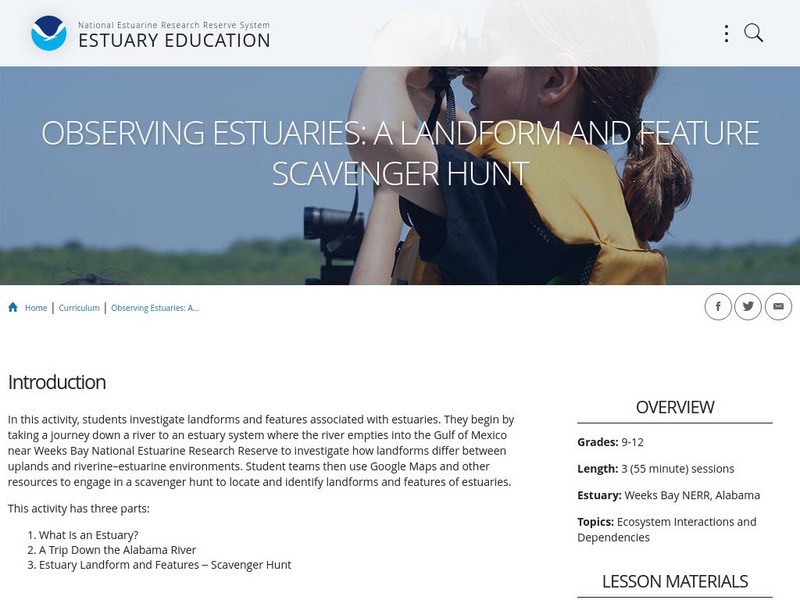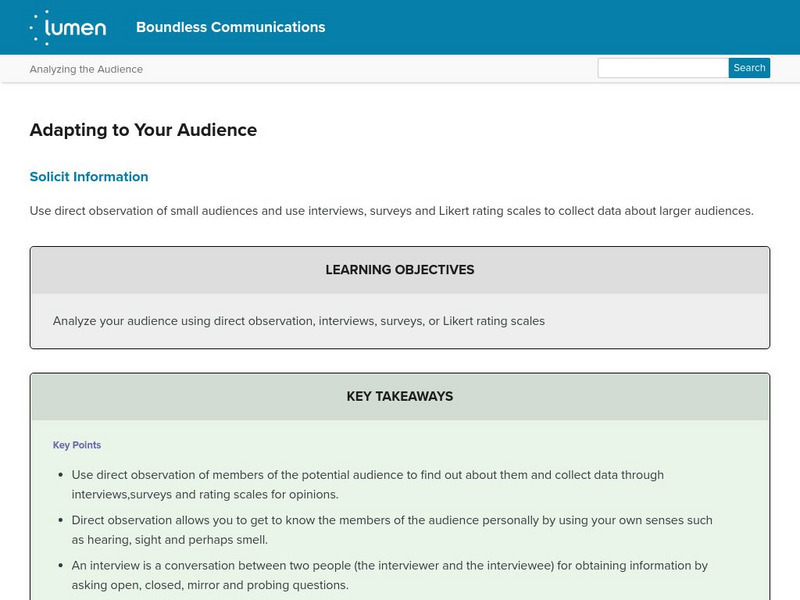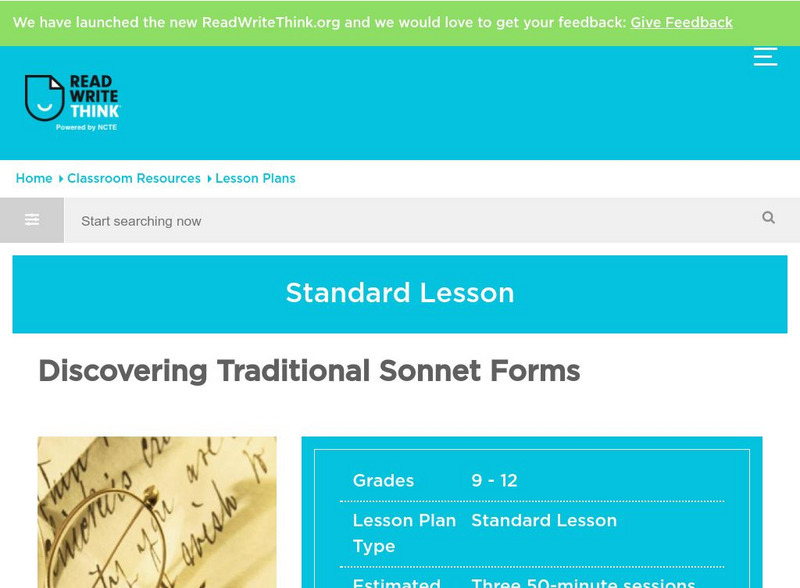BioEd Online
Bio Ed Online: The Science of Microbes: Magnifying and Observing Cells
In this activity, middle schoolers create slides of plant cells and observe them under a microscope. The lesson and PowerPoint slides can be downloaded. The included instructional video on cell observation is 20 min. 44 sec.
BioEd Online
Bio Ed Online: The Science of Microbes: Observing Different Microbes
Learners prepare slides of and examine three types of common microbes using a light microscope, recording what they observe. The lesson plan and a set of PowerPoint slides can be downloaded. An accompanying instructional video is 22 min....
ReadWriteThink
Read Write Think: Webcams in the Classroom: Animal Inquiry and Observation
Observe animal behavior patterns and their habitats using one of the many webcams broadcasting from zoos and aquariums around the United States and the world in this inquiry-based activity that focuses on observation logs, class...
CPALMS
Florida State University Cpalms: Florida Students: Observation vs. Inference
A tutorial that explores the differences between scientific observation and scientific inference.
Science Education Resource Center at Carleton College
Serc: Classroom Phenology: The Environment a Source of Data and Observations
A unit where young scholars record daily temperatures, precipitation amounts, observations of weather patterns, shadow length of a set object, and other observations. In addition, they will complete a season-long weekly observation of a...
University of Kentucky
Uk: Starting an Observation Hive of Honey Bees
This interesting site explains how one goes about creating a honey bee hive for observation purposes.
US Environmental Protection Agency
Epa: Observing Buffers in Lakes, Ponds, and Streams
Explore buffers in lakes, ponds, and streams. "In this experiment, you will observe the effects of limestone on the acidity of water."
Illustrative Mathematics
Illustrative Mathematics: 8.ee Sammy's Chipmunk and Squirrel Observations
In the context of this task, a student is observing a squirrel and a chipmunk for their acorn-hiding habits. The problem requires students to use a linear equation to find out how many acorns the chipmunk hid. Aligns with 8.EE.C.7.
PBS
Pbs Learning Media: Observing Refraction of Light
This video segment adapted from Shedding Light on Science illustrates how light changes speed, and thus direction, in a process known as refraction. Includes background reading and discussion questions. [2:05]
NOAA
Noaa: Estuaries 101 Curriculum: Observing Estuaries:
Students investigate landforms and features associated with estuaries by taking a journey down a river to an estuary system where the river empties into the Gulf of Mexico near Weeks Bay. They will use Google Maps and other resources to...
Science Struck
Science Struck: Qualitative and Quantitative Observations
Explains what qualitative and quantitative observations are and what they look like in science. Includes examples that highlight their differences.
Simon Fraser University
Chem1 Virtual Textbook: Observable Properties of Gases
The General Chemistry Virtual Textbook, or Chem 1, is broken into several sections covering various aspects of topics related to chemistry. This section deals specifically with the properties of gases including subtopics such as the...
PBS
Pbs Learning Media: Observe Images of Different Climate Zones
Interact with this world map from McDougal Littell/TERC to highlight different climate zones and see a photograph of each one. Ten climate zones are represented, including tundra, desert, humid subtropical, and others.
BBC
Bbc Bitesize Revision: Observation
As part of a revision and writing section of BBC Bitesize, this site goes over several tips of general advice to keep in mind when writing about observations (as part of descriptive writing).
ReadWriteThink
Read Write Think: Book Sorting: Using Observation and Comprehension
Critical thinking, comprehension and analysis skills are the focus of this physical activity. Good beginning to teaching different ways of looking at things.
CK-12 Foundation
Ck 12: Algebra Ii: 5.6 Observational Studies, Experiments, and Surveys
This section explores how to design and conduct surveys that accurately reflect the perspectives of a larger group of people by identifying unbiased sample groups and by writing unbiased questions.
Huntington Library
Huntington Library: Making Community Measurements: Which Plant Part? [Pdf]
A lesson in observing a plant or plant community in different seasons for the purposes of recording observable changes.
Other
Center for Educational Resources: Sky Paths
Lesson activities where students observe and describe the movements of objects in the sky in both daytime and nighttime. They learn how early cultures regarded the skies, and the stories they told about them. Students will be given the...
Other
Catholic Culture: Catholic Activity: Carnival or Mardi Gras
Maria Augusta Trapp explains the origin of the time of feasting and revelry between Epiphany and Ash Wednesday, the seasonal celebration of Mardi Gras, which marks the beginning of Lent. Article also touches on the related tradition of...
Lumen Learning
Lumen: Boundless Communications: Adapting to Your Audience
This lesson focuses on adapting your speech to your audience including analyzing your audience using direct observation, interviews, surveys, or Likert rating scales and then apply knowledge about the audience to adjust the message...
Crescent Public Schools
Crescent Public Schools: Educational Theories
Presents some of the major theories of learning, their principles, and how they impact learning. Covers constructivism, behaviorism, Jean Piaget's developmental model, brain-based learning theory, control theory of motivation,...
ReadWriteThink
Read Write Think: Discovering Traditional Sonnet Forms
This lesson allows students read various sonnets and chart the basic characteristics of the poem, using their observations about traditional sonnet forms. After, students write original sonnets, using one of the poems they have analyzed...
NOAA
Noaa: National Weather Service: Remote Sensing
The National Weather Service presents this site on remote sensing. Learn about Doppler radar, the Automated Surface Observing System (ASOS), and radiosondes. Review questions included.
NASA
Nasa: Imagine the Universe: Pulsars
Resource explores what a pulsar is, as well as what is currently known about this phenomenon. Content includes a focus on x-ray observations of pulsars, and gamma-ray pulsars.
Other popular searches
- Observe Physical Properties
- Observe the Night Sky
- Scientific Process Observe
- Predict Observe Explain
- Observe Stomata
- Observe and Infer
- 5 Senses to Observe
- Observe and Classify
- Fire Drill Observe
- Observe Fungus
- Cooperative Observer Network
- Observed Change
















